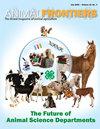提高水产养殖中的鱼类生产性能
IF 3.2
2区 农林科学
Q1 AGRICULTURE, DAIRY & ANIMAL SCIENCE
引用次数: 4
摘要
联合国粮食及农业组织将水产养殖定义为水生生物的养殖,包括鱼类、软体动物、甲壳类动物和水生植物,其中养殖意味着对饲养过程进行某种形式的干预,并意味着个人或公司对所养殖的种群拥有所有权(粮农组织,1988年)。在最近的一份报告中,粮农组织强调了加强水产养殖生产的重要性,以应对到2050年养活预计将达到96亿的全球人口的艰巨挑战(粮农组织,2014年)。目前,全球鱼类产量的增长超过了人口的增长,这在很大程度上是由于水产养殖生产的重大进展。因此,水产养殖目前生产了人类消费鱼类的一半以上,预计到2030年将增加到62%,以满足不断增长的需求(粮农组织,2014年)。虽然已经研究了各种各样的技术来提高鱼类的生长和性能,但生产力在很大程度上取决于基因型、营养和环境之间的相互作用。鱼类遗传、营养和饲养、养殖系统和管理方面的重大进展已逐步提高了鱼类生产性能,并提高了全球总体生产力。本文讨论了这些领域的技术进步,以提高水产养殖中鱼类的生产性能。本文章由计算机程序翻译,如有差异,请以英文原文为准。
Enhancing fish performance in aquaculture
The Food and Agriculture Organization of the United Nations defines aquaculture as farming of aquatic organisms including fish, mollusks, crustaceans, and aquatic plants where farming implies some form of intervention in the rearing process and individual or corporate ownership of the stock being cultivated (FAO, 1988). In a recent report, the Food and Agriculture Organization emphasized the importance of enhancing aquaculture production to meet the daunting challenge of feeding a global population expected to reach 9.6 billion people by 2050 (FAO, 2014). At present, increases in fish production globally outpace population growth, largely due to important advances in aquaculture production. As a result, aquaculture now produces more than half of the fish consumed by humans and is projected to increase to 62% by 2030 to meet increasing demand (FAO, 2014). Although various types of technologies have been examined to improve fish growth and performance, productivity largely depends on interactions among genotype, nutrition, and environment. Significant advances in fish genetics, nutrition and feeding, culture systems, and management have cumulatively enhanced fish performance and increased overall global productivity. Technological advancements in these areas that enhance fish performance in aquaculture are discussed in this review.
求助全文
通过发布文献求助,成功后即可免费获取论文全文。
去求助
来源期刊

Animal Frontiers
Veterinary-Food Animals
CiteScore
6.50
自引率
5.60%
发文量
74
期刊介绍:
Animal Frontiers is the official journal of the following globally active professional animal science societies:
ASAS, the American Society of Animal Science
CSAS, the Canadian Society of Animal Science
EAAP, the European Federation of Animal Science
AMSA, the American Meat Science Association
These organizations are dedicated to the advancement and dissemination of science-based knowledge concerning animal agriculture. Animal Frontiers provides a novel forum for innovative and timely perspectives that have relevance to understanding the complex dynamics at work through animal agriculture. Animal Frontiers publishes discussion and position papers that present several international perspectives on the status of high-impact, global issues in animal agriculture. Every issue will explore a theme of broad and current interest within animal science and animal agriculture.
 求助内容:
求助内容: 应助结果提醒方式:
应助结果提醒方式:


